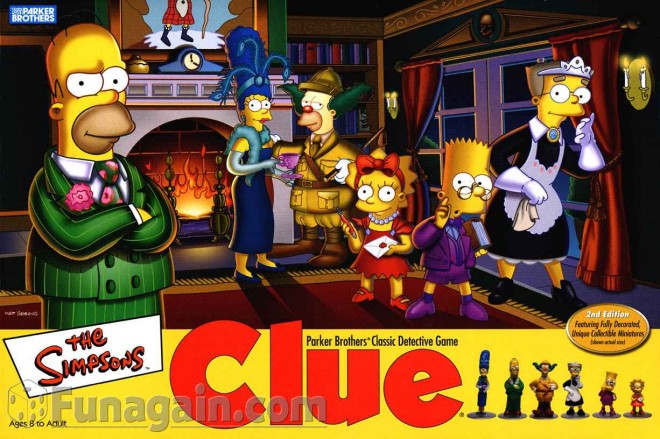
Amy Cobos
Clue: The Simpson’s Edition
Clue is a game created by Hasbro that I already knew how to play coming into HY 300 History of Games. It is an epic game full of mystery and adventure that people of all ages will enjoy playing. It has a storytelling theme of uncovering a murder that has happened in a mansion where the millionaire owner has been murdered. It is up to the players to discover who was the murderer, what weapon did he or she use and in what room did the murder occur? Clue engages its players to follow the adventure turn by turn while uncovering certain clues to the identity of the murder and what caused it and where it happened. Was it Marge with the poison donut in the Nuclear Power Plant? Homer with the Slingshot in Burn’s Manor? Or was it Lisa with the necklace in The Simpson House? Players will need to dive into the world of Clue to find out!
Steps:
To play Clue in class, we used The Simpson’s version provided by Dr. Peterson. This made the game more relevant to the players because The Simpson’s is a huge cultural phenomenon that everyone has at least some prior knowledge about.
- We played with five players. Each player chose their own specific character to play. I played as Lisa Simpson, who is a substitute for Ms. Scarlet in the original version.
- We then set up the game by selecting a suspect card, weapon card and location card to stick in the confidential envelop. These would be the cards that we would be guessing about throughout the game. We then shuffled together the remaining cards and distributed them out to each player. These would be the cards we would mark on our detective notepads and know for a fact that they are not the culprits of the murder
- Once everyone had marked their detective notepads, we rolled to see who would go first. We would then play in a clockwise direction. The rolling of dice would determine how many spaces each character would get to move on their turn. This is what would get each player to a location they would like to investigate and be able to make presumptions.
- When a player finally made it into a location, they would be allowed to make an assumption about a suspect and a weapon. Their assumption would have to include the room that they are currently in.
- An assumption, for example, sounded like this: “I believe it was Lisa, with the necklace in The Simpson House.” The player to the left would be able to go through their personal clue cards and if they have a card that can prove that player who made the assumption wrong, then they must show that player, and only that player, the card. If the player to their immediately left cannot prove them wrong, they must say “I cannot prove you wrong.” Then the next player to their left would go through their cards and see if they could prove the accusation wrong. This continues until the player is proved wrong.
- If the player cannot be proven wrong by any of the other players, then that player is allowed to make an accusation. When a player is making an accusation, they must be in the location they believed the murder occurred. Then they must say “I accuse Lisa, with the Necklace, in The Simpson House.”
- Once a player says this statement, then they must open up the confidential envelop in private to see if they are right. If they are incorrect, they must secretly put the cards back and they are out of the game. If they are correct, then that player wins!
We all enjoyed playing Clue very much not for its storytelling theme, but also for its competitive nature. While the game is mostly based on chance, by rolling a dice and guessing, it can still get very competitive between players because you want to be the first one to figure out the mystery. This game can include sabotage because the player to your left can continually show you the same card over and over again, allowing you to not gain any new information. Clue is one of my personal favorite games because it can be a great party game with friends that leads to a fun night of mystery and adventure.
